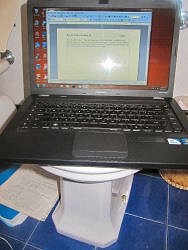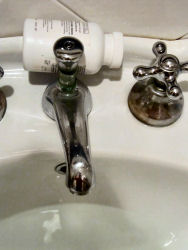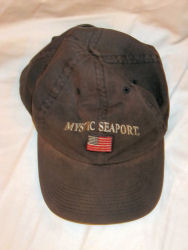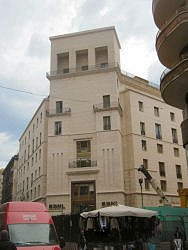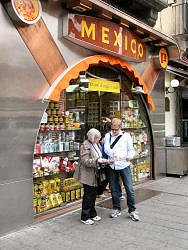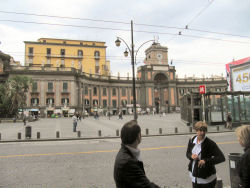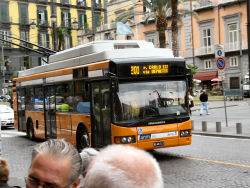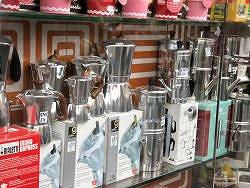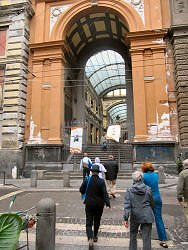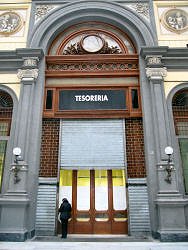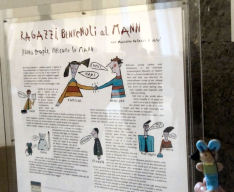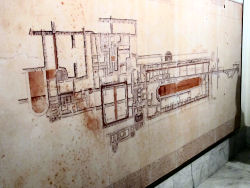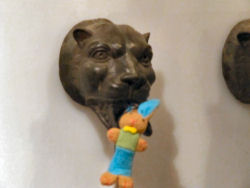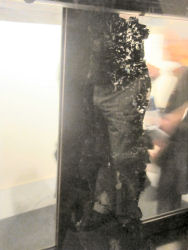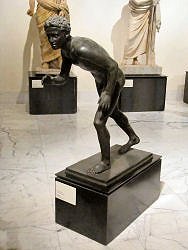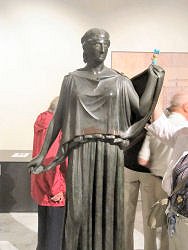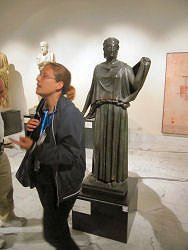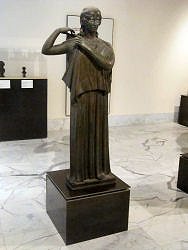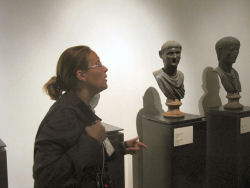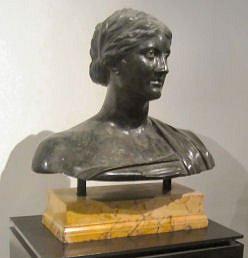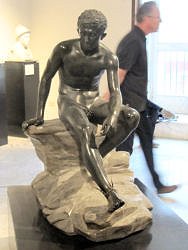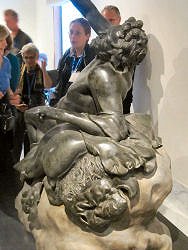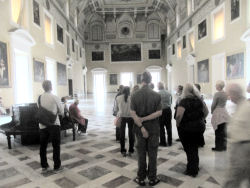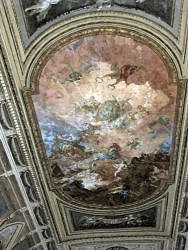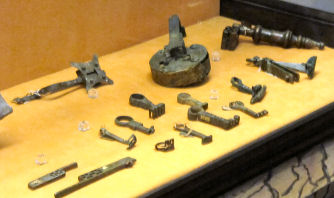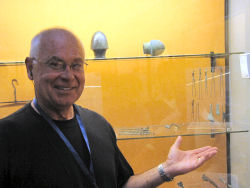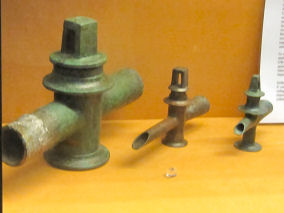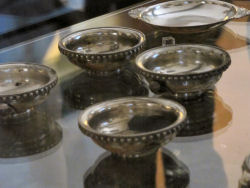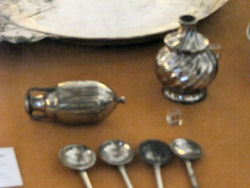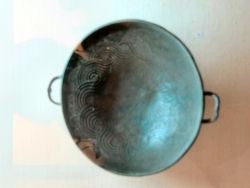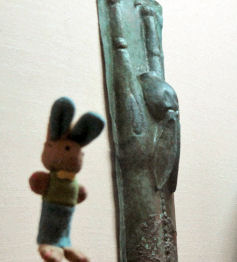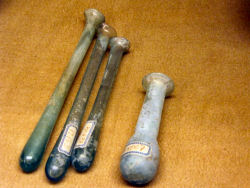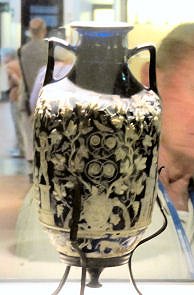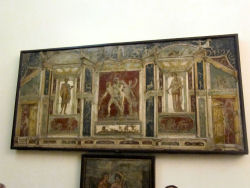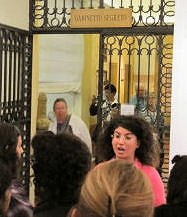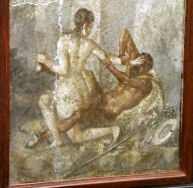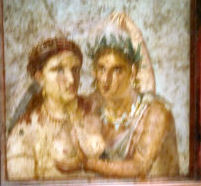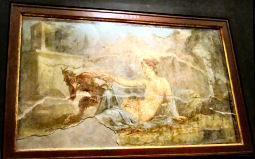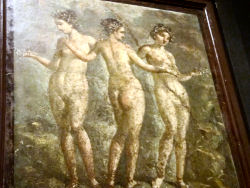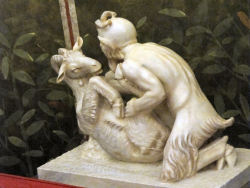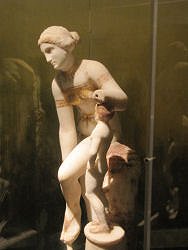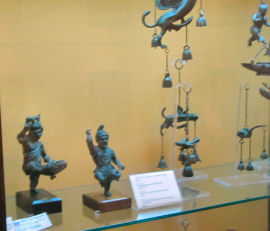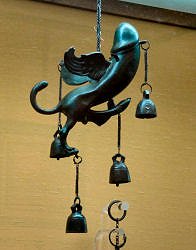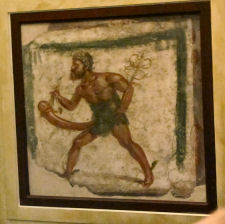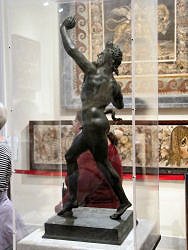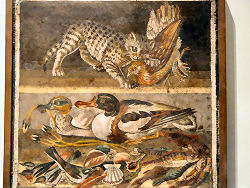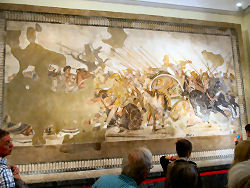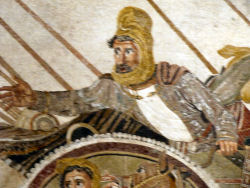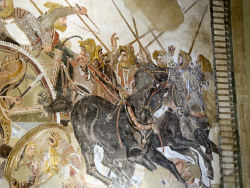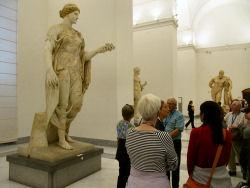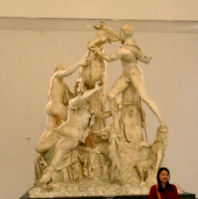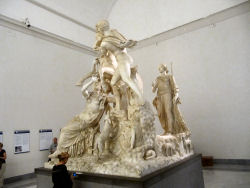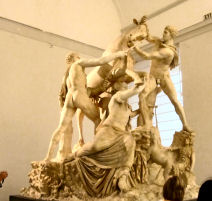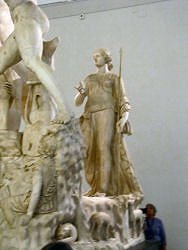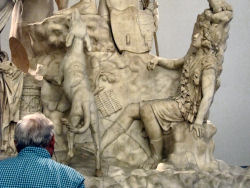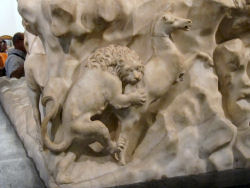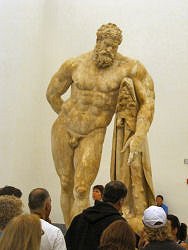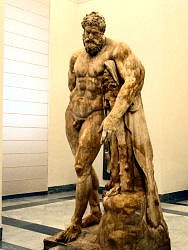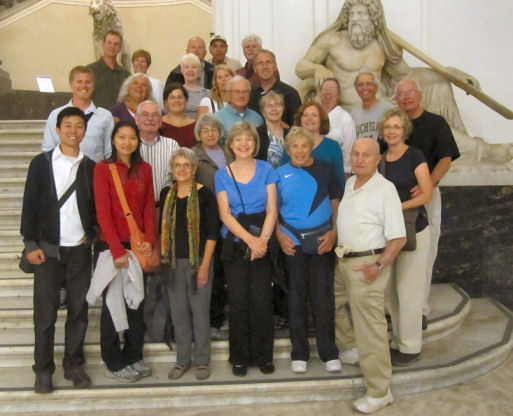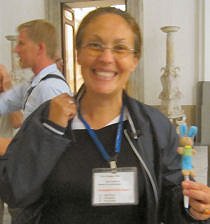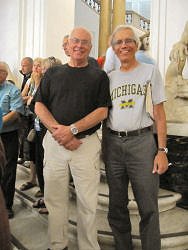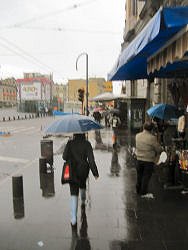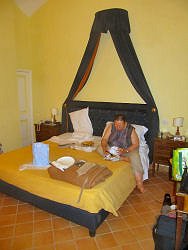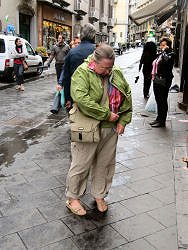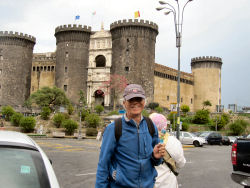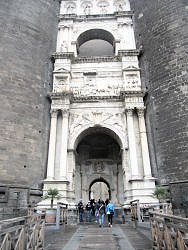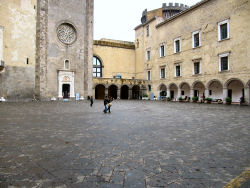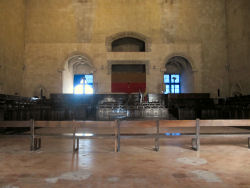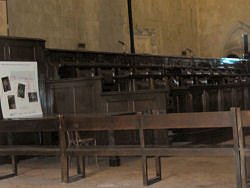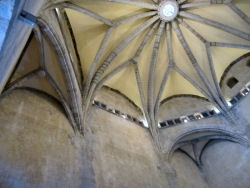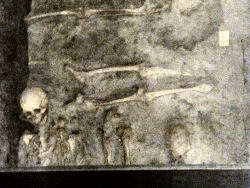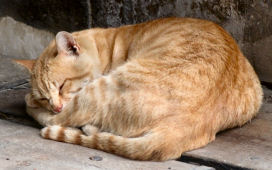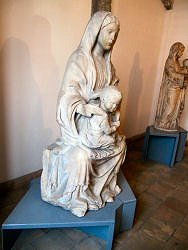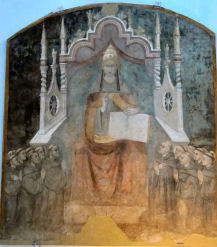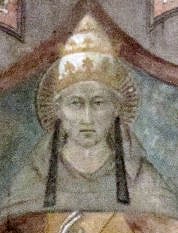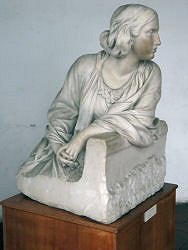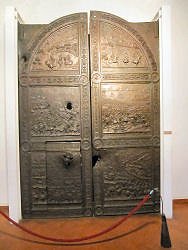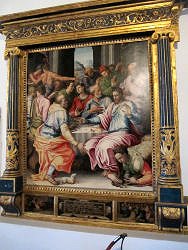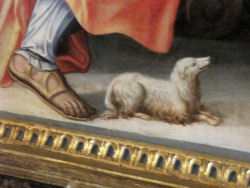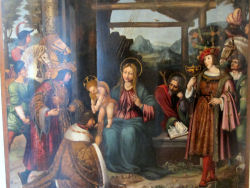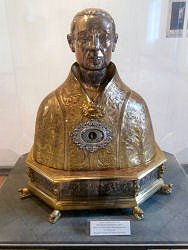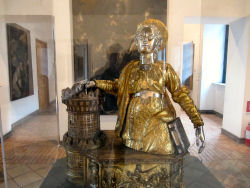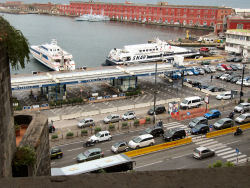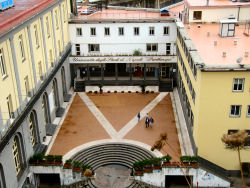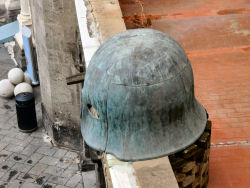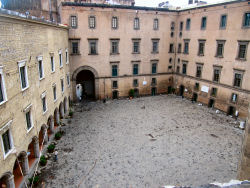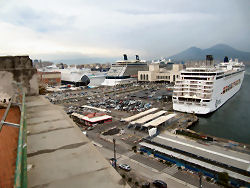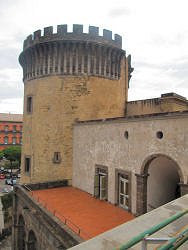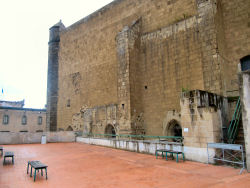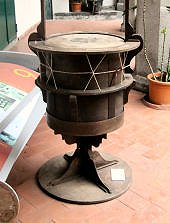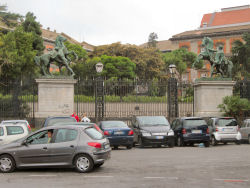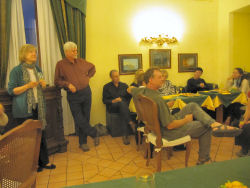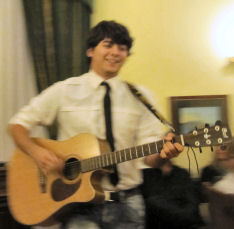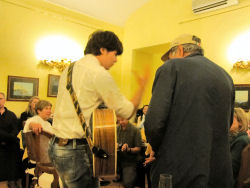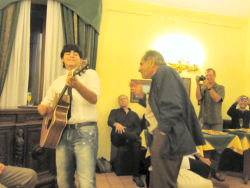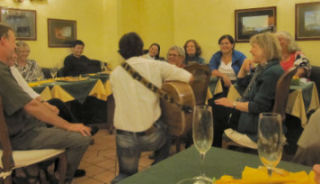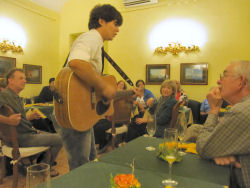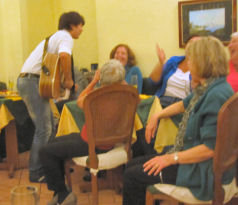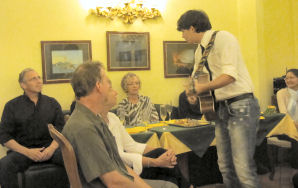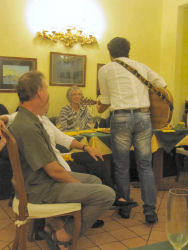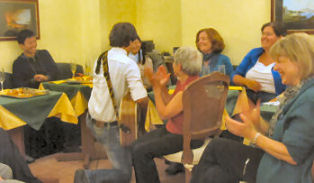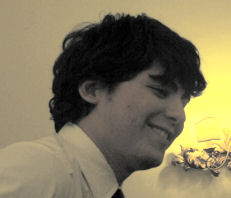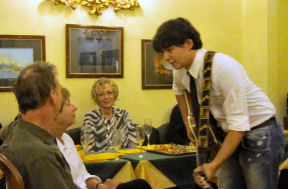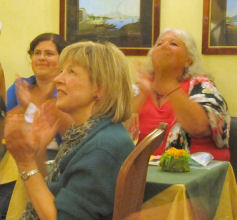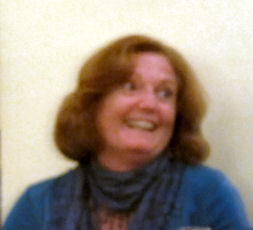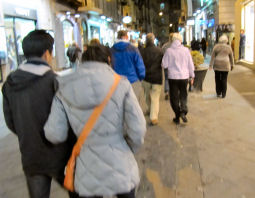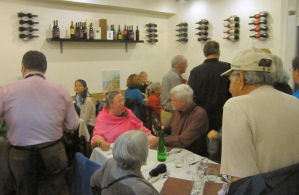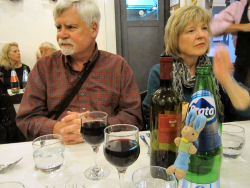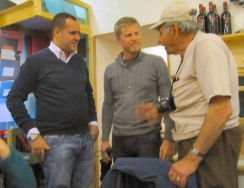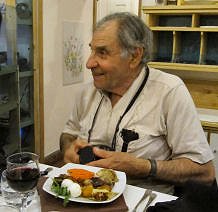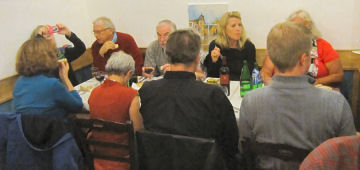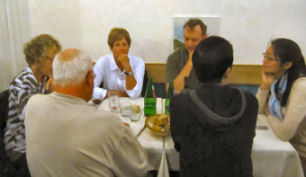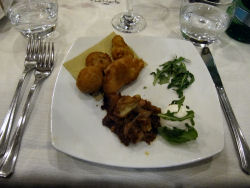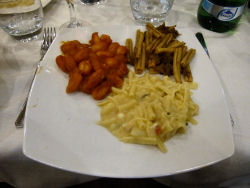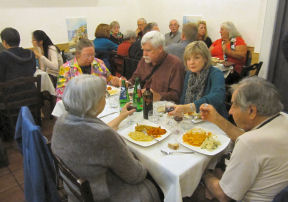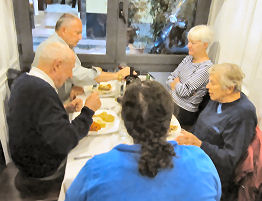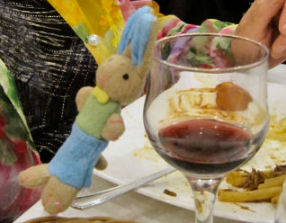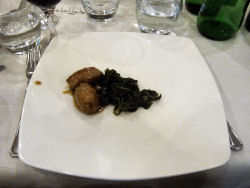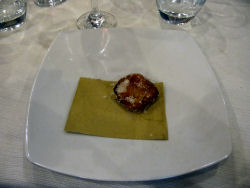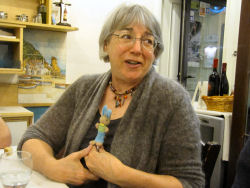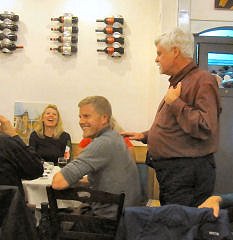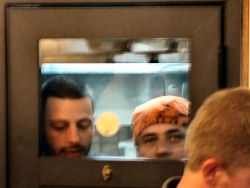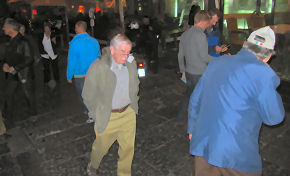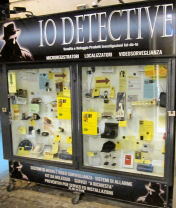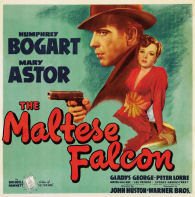I woke up a little before five, the same time that I ordinarily arose back in Connecticut. Feeling somewhat energetic, I tiptoed into the bathroom to get some work done. I could turn on the light there without disturbing Sue. Sue had left a note in the bathroom with the information for accessing the hotel’s wi-fi as well as the times for breakfast (7:30) and the assembly (9:00) for our walk to the Archeological Museum.
The first order of business was to get one of my camera batteries charging. Then, after I had downloaded my photos to my laptop, I transcribed my notes from Thursday to a word processing document. I sat on the floor and used the bidet as a table for my computer; I have no pride whatsoever. After an hour, however, my bony butt could no longer tolerate the tiles. I arose and then seated myself on the toilet with the computer balanced on my lap. There was no good place to put the mouse, but I did not expect that to slow me down. When I needed it, I pressed it against my leg.
The weather had turned chilly, and the sky was overcast. Weather.com had forecasted that the high would only be in the sixties. The good news was that there was only a 20 percent chance of rain. Nevertheless, it sure looked threatening. I regretted bragging to Rainer about the great weather that Sue and I had experienced on our Rick Steves tours. Worst of all, Renee and her magic umbrella had departed the tour early. Rumor had it that she had received the talisman from a Hopi shaman in Arizona who guaranteed that it would ward off inclement weather,
Sue and Gail decided to take a cab to the museum. The rest of us hoofed it.
On the walk to the museum I was astounded to learn that Rainer, whose man-purse carried the label of “Jack Spade,” had never heard of Sam Spade. In order to complete his education, he, along with every other young man, should forthwith be required to read Dashiel Hammett’s novel and then watch Humphrey Bogart and Mary Astor chew up the scenery. The way that Bogart spits out the word “sap” at the end is enough by itself to make this movie de rigeur for any cultured westerner.We walked up Via Toledo toward the Archeological Museum. Judy had previously asked me to tell her a pope story. I therefore spent the first part of the walk relating the tale of the hapless thirteenth-century pope (and saint) who spent his entire pontificate in Naples, Celestine V. She seemed quite startled or at least amused by it, but she may have just been placating me.
I honestly could not understand the attraction of this place. There was no seating and almost nowhere to stand. People paid for their coffee at the register, shoved their way up to the counter, gave their order to one of the white-clad men, waited a couple of minutes watching the other white-clad man manipulate the espresso machine, spent another minute or two drinking their brew wherever they could find a square foot of floor space, and then left. What about this qualified it as a pleasant cultural event? It certainly did nothing for me.
Rainer explained that the stovetop coffee-makers in Naples differed from those used in the rest of Italy. Many were on display in the window; they looked like tiny percolators. Drip coffee was evidently nowhere to be found on the Boot. Rainer informed us that our local guide in Naples, Pina Caruso, had recently had given birth to a baby.We stopped at another galleria just before we reached the museum. Rainer used one of the bancomats therein to withdraw money for our tickets. I noticed that one of the establishments there was labeled as Tesoreria. I knew that tesoro was the Italian word for treasure. The “-eria” part ordinarily meant that it was a store. I could not figure out what it could have been.[2]
It began to rain a little just as we entered the museum. I smugly assured myself that it would probably rain while we were touring the museum and then stop in time for our return walk back to the hotel.Sue and Gail had already arrived. The group again met up with Pina, who showed us the lockers in which we were allowed to place our bags and backpacks. They did not allow visitors to use them for jackets, but you could insert your jacket into your backpack as I did, and then put the backpack in the locker. The policy made no sense to me whatever. If I had needed to stow my jacket, I would have made a show of putting it into an imaginary translucent bag.
I inserted my backpack into locker #P. Right below it was locker #p. The two symbols were precisely identical in shape, but the lower one was slightly smaller. It occurred to me that they might have been slightly more imaginative in their scheme for labeling the lockers. The collection in this museum was composed of the statuary that Pope Paul III[3] had thoughtfully looted from the baths of Caracalla as well as the results of the excavations conducted at Pompeii and Herculaneum. All told there were over ten thousand artifacts. We started with the exhibits on the second floor.The Getty Museum in Los Angeles had constructed a reproduction of the villa on a smaller scale.
Fifty-seven bronze statues were recovered from the villa. This constituted the largest extant assemblage of Roman bronzes anywhere. In the Middle Ages most bronze objects had been melted down and made into cannons and other objects. Bronze was considered too precious to waste on art.
Most of the works were copies of Greek originals, but the craftsmanship was truly astounding. The statues had eyes that were made of Egyptian Ivory. The one called Athlete seemed to be much more fluid than most of the others.
The Romans had copied the Greek statues, poetry, and every other art. According to Pina, the greatest compliment that an artist could be paid was that his work could not be copied. The original Greek statues have almost all been lost, but the Romans made exquisite copies in marble. The villa was discovered in 1738, but it was not excavated until 1927 because it was under one hundred feet of mud. The pool was sixty-six meters in length.The five or six bronze sculptures that were labeled Dancer showed the idealized (Pina called them “stereotyped”) features of a dancer rather than the real features of a specific person. Thus, the actions of the dance themselves were emphasized rather than who was doing them. This was typical of the Greek approach to sculpture.
The Roman sculptures of emperors and other important people, on the other hand, more accurately depicted the real features. The one once considered to be of Seneca, however, was likely just the idealized depiction of a philosophical person. Pina opined that all that it needed was a pair of glasses.The statue of Hermes was detailed and showed all of the god’s usual iconography. The wings on the feet were a giveaway.
The bronze statue of the drunken satyr was so detailed that it could not be duplicated by any modern artist, not even Rodin. To this day, no one knows how the ancient artist (or maybe artists) were able to do it.The building now devoted to the museum was originally constructed in the sixteenth century. From 1585 to 1777 it housed the University of Frederick II. The king[4] then directed that it be used as a museum. That made this the oldest archeological museum in the world.
The figure in the fresco on the ceiling who resembled George Washington was actually King Ferdinand I. His wife, Maria Carolina, was the sister of Emperor Joseph II and Marie Antoinette. Over one hundred country village houses were found in Pompeii. The bronze used in the statuary was 75 percent copper, which was exceptionally high.In 1926 the Casa del Menandro was found. Inside a big bronze box discovered there were 180 silver objects that weighed fifty pounds. Along with a wine-tasting cup were found tiny silver cups for quail eggs.
Over the years thirty-four bakeries were unearthed in Pompeii. I took photos of Benino with the pieces that had rabbits on them. Pina pointed out a couple of them to us. I could not help noticing that she seemed to be quite taken with Benino. Everyone was whispering about the sparks that seemed to be flying between them.At about the time that the tour group was inspecting the collection of silver objects, it became obvious that it was raining gatti e cani outside. I began to wonder if I had mistakenly consulted the forecast for Naples, FL, that morning.
Next we examined some amazing blown glass items from the first century BC. Pina told us that the first glass items had been crafted by the Phoenicians four thousand years ago. Many of the ones on display were discovered in mausoleums that protected them from the debris of the volcano. There were only six ash urns in the world from Roman times.
The incredible Blue Vase on display used the cameo technique. Pina asserted that the most talented glassblowers in Murano would be at a loss to explain how it was ever done. The entire work would need to be completed in only a few hours.
The primary religion in Pompeii was the mysteric religion of Bacchus. I think that that is what Pina called it; I had never encountered the word “mysteric” before. The worshipers of Bacchus used wine for their purification ceremonies in much the same way that the Christian religions and the cult of Isis used water. For ten years the museum’s collection of frescoes had not been accessible to the public. Now they were on display, but the facility was not air conditioned, and the windows were often opened throughout the summer. Pina lamented the fact that the curators were not doing a very good job of protecting their prizes from the elements. Evidently budgetary problems prohibited creation of an appropriate space.The red in the frescoes could never be copied because it used cinnabar, an extremely dangerous form of the poisonous mercuric sulfide.
A German group had categorized the four styles of architecture in Pompeii: 1) three-dimensional; 2) flat with perspective; 3) focused on mythological characters; 4) baroque. Pina showed us examples of each in the frescoes.In the last years before the volcano erupted, houses in Pompeii were using sliding doors and folding gates.
All of us except Benino were old enough to take a peak at the erotic drawings in the Gabinetto Segreto. In the eighteenth and nineteenth centuries this room was called the pornography collection.
Many of the paintings portrayed different versions of the same joke. It went something like this: A satyr approaches a sexy-looking woman. However, when she shows her junk to him, he realizes that he/she is actually a hermaphrodite. He tries to escape in horror. Sometimes he succeeds; sometimes he is trapped.In one painting there were two women; one was a Bacchante.
Canova based his statue of the three graces on one of the paintings.One statue depicted a woman in a bikini.
Pompeii was originally known as Colonia Veneria Cornelia Pompeiianorum.
The explicit statue of Pan and the goat was considered the most scandalous, but, as Pina explained, it was not bestiality if both participants were consenting beasts.
Thirty brothels had been found in Pompeii. So, the markets for bread and sex in the town were roughly equal.
Many depictions of phalluses and phallus-shaped objects were found because they were considered to have the property of helping ward off the evil eye (malocchio).[5] Later horns and chili peppers were used as substitutes.
The Faun was the only bronze statue that was an original Greek piece from the fourth century BC.
The enormous mosaic of the battle between Alexander the Great and King Darius was originally on the floor in a house in Pompeii. Alexander was an idealized caricature, but there was real fear in Darius’s eyes as he watched Alexander slaying a Persian with one of his two short spears. The Persians carried spears that were seven meters long! Each warrior obviously could only handle one. The work, which has quite good perspective, is composed of two million or so pieces. It was removed in toto.
Pope Paul III decided to display some of the oversized statuary that he had liberated from the Baths of Caracalla in his family’s residence. My considered opinion is that you really have to give the popes – and especially their relatives – credit for their creativity.
I recorded in my spiral notebook that Pina said that Adriana was twice as large as Pompeii. I think that she must have been referring to the villa that we toured in Tivoli. It is sometimes called Villa Hadriana, and the Italians never pronounce H’s.
The Farnese bull, the most famous piece in the entire museum, was originally fashioned from one block of marble. Antiope was depicted in the foreground. Nemesis was in the background. The work was found in several pieces. Michelangelo reconstructed it and added to it. The dog, the trunk (?), and other details were his work.
The statue of Hercules was also in several pieces. This version of Hercules could easily hold his own against Hulk Hogan[6] in his prime. I wonder who posed for it.
As usual, Pina blamed the damage to the statue on the “Spaniards,” by which she seemed to mean the troops of Emperor Charles V.[7] The statue had been reconstructed with Renaissance legs. It had a signature, but I did not see it.
This was a marvelous tour. Pina’s performance was extremely impressive; I enjoyed her observations much more than I had on Thursday. This was for me the highlight of the entire journey since we had departed from Rome. The only way that it could have been better would have been with a better sound system.
The museum was more crowded than the Capodimonte Musem had been on Thursday, but we were almost never impeded. It seemed evident that either tourists were ignorant of this unmatched collection or that they were too afraid of Naples to take advantage of it.
Rainer asked to use my camera for the group photo after he ascertained that I had a USB cable for downloading to his Mac. Pina snapped two photos. She thought that the camera did not work because it said “Busy,” but it did.[8]
Benino was perched on Sue’s right shoulder for both shots, but he was not visible behind Debbie’s head.
For some reason Sue was not thrilled by the prospect of walking back to the hotel in the rain. She shared a cab with Amy, Gail, and Debbie.After the group photo I started to walk out of the museum with Ed and Diann who were following Jeff and Robbie down a long corridor toward the main door. I turned around because I deemed it prudent to use the toilet before before beginning the trek back to the hotel. There was a line for the men’s bathroom, and four teenagers were in front of me. They did not seem to understand the drill at all; men are not accustomed to lines in bathrooms.
I found the guardaroba and fought my way through a platoon of German tourists to locker #P. I extracted my pancho from my backpack and put it on, being careful to cover my backpack. I then set out alone down the Spaccanapoli in what had become a light rain.
Despite the weather, the walk back was, on the whole, rather pleasant. Most people on the street sported umbrellas, but I was much less encumbered. However, by the time that I reached the hotel, my green pants were quite wet from the knees down, especially in the back. Evidently my heels flipped up some water on the back of my legs.By the time that I arrived at the hotel, Sue was already there. I took a photo of the room and had pizza and water for lunch. I napped until 2:30 while Sue logged onto the Internet.
Our plan for the afternoon was to visit Castel Nuovo, the castle built by King Charles I in the thirteenth century. A little later it served as the headquarters of the ill-fated Pope Celestine V.[9] It would be great if the room that the pontiff inhabited during his short pontificate were open to the public. I had my doubts, however. The castle was not considered one of the top attractions of Naples, and no one seemed to know its incredible history. It did not merit a mention in Rick Steves’ guidebook.
We felt a drop or two on the short walk to the castle, but not enough to merit taking action. Sue wore the butt-ugly green jacket that she had purchased for our very first ETBD tour eight years ago. I wore my jacket, but my pancho stayed in my backpack.We strolled past the San Carlo opera house toward Castel Nuovo. Sue thought that I was going the wrong way, but she had confused the Piazza Trieste e Trento with the Piazza del Plebiscito. It only took us a few minutes to reach the castle. I took some photos from the outside with the idea of replacing the one in my book.
I bought two admissions for €6 each. They gave us a little pamphlet to use for orientation.We sat on a bench and read the pamphlet. The castle had been renovated and expanded many times since it had been constructed in the thirteenth century. Absolutely no mention was made of Pope Celestine V or his landlord, King Charles II. I could not be certain, but it appeared that almost nothing remained of the original structure.
We tried to find our way around on that level, but the only room that was open to the public seemed to be the Baron’s Hall. So, we walked back down the staircase to the ground floor.
The pamphlet said that the tour started with the Santa Barbara Chapel, so that was where we went. We looked at most of the materials there and in the adjoining room, but we were not too impressed. This room once was entirely covered with frescoes by Giotto and his assistants, but very little of this work remained.
As we were leaving the chapel, however, I noticed that one character in a faded fresco on the wall on the right side was wearing a cone-shaped tiara, the one certain identifier of a pope. I read the inscription and it identified the pontifical figure as “San Pietro Celestino.” The scarcely visible halo confirmed it. There was no doubt that it was a depiction of Pope Celestine V. I took enough photos so that I was reasonably certain that at least one was usable.
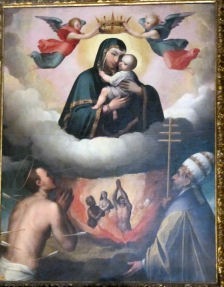
Sue and I finished examining the remainder of the exhibits on the first floor. She had dealt with enough steps for one museum and offered to remain below while I explored the upper floors.
The second floor contained some paintings from before the Renaissance. A few were somewhat interesting, but none of them wowed me or even slowed me down much.
The third floor had more modern paintings. A few of these had a little historical interest to me, but I did not know enough Neapolitan history to put them into context. So, I browsed through them rather rapidly as well.
The people at the museum’s desk had told Sue that one tower was open, but when I got there, it was blocked off by something that slightly resembled a bicycle rack. This was not a great disappointment. The top of the tower was not much higher than the base of the blocked stairs, and, in fact, other parts of the castle were higher than that tower. So, I took some photos of the harbor and the street below me from my vantage point on the far rampart.
I then beat a path down to the courtyard where Sue awaited. This museum was definitely NOT worth the €6. It was poorly laid out, poorly equipped, and poorly staffed. I was quite pleased that I managed to get a photo of the fresco of Pope Celestine V, but I would never consider visiting it again.
We considered stopping at the famous San Carlo Opera House for a tour, but neither of us was exactly overflowing with energy. We had taken such tours in Milan and Budapest. Mostly they emphasize the royal boxes and a few historical elements. I would have gone in a New York minute if I thought that they might take us backstage and show us some of the rigging and the staging tricks.
Sue and I had hoped to get to attend an opera on this trip. Unfortunately, September and early October were the worst times for opera. The summer outdoor season was over, and the regular season had not yet begun. Neither the Roman nor Neapolitan companies had anything scheduled during the times of our visit.
We declared the touristy part of our vacation officially over and walked back to the hotel. The portone was open, so we did not have to ring for admission. Sue watched television while I took a shower and dressed for the Happy Hour that Rainer had scheduled for six o'clock. When I emerged from my ablutions, I found her watching a silly old black and white movie starring Alberto Sordi. Albertone had entered a walking race to impress a girl or something. It must have been in dialect; I could scarcely understand a word that anyone was saying, but there was plenty of slapstick, and the plot was simplistic.
The Happy Hour featured prosecco and some appetizers that resembled miniature pizzas. Rainer asked if anything interesting had happened. Evidently Gail had engaged a cab driver in conversation, and he expressed a strong interest in engaging in more intimate activities.
Then Rainer introduced the highlight of the evening, a young energetic singer and guitar-player named Mario. The room was small, but Mario took advantage of every inch of space by moving around and singing a line or two to particular people.
I recognized his first song from my Roberto Murolo album and the second one from the portion of one of my Acquerello Italiano tapes of Renzo Albore. Mario brought Frank up to play the part of Rudolph Valentino before his rendition of “O Saracina.” Mario also misinterpreted something that Frank had said as a request for “O sole mio” and “Volare.” Actually Frank had repeatedly disparaged both songs.
The most memorable moment was when Debbie took advantage of one of the intimate serenades to grab Mario by the tie and pull his face close to hers. For once Mario was absolutely speechless. It must be a little weird for a twenty-one-year old to experience such behavior from geezers like us. I mean, some members of the group were a generation older than I was, and I was old enough to be his grandfather. At the end Mario recovered his aplomb and presented Debbie with his tie. That was a really classy move. If he ever needs a tie, I have a few that I could spare.As we went to supper, Mario came out wearing a Superman pullover and his guitar strapped to his back. Super Mario!
When we left the hotel we had always turned left and headed down Via Chiaia. For our last supper, however, Rainer led us up the street. We walked a few blocks to a very small restaurant named L'Antica Latteria.[10] We were crowded into a small dining room. I did not see how they could possibly have handled the whole group if Renee and the Corcorans had been present.Sue and I sat with Judy, Frank, Steve, and Edie. We were served bread, water, and red wine followed by – on square plates – appetizers of mozzarella wrapped in arugula, fried cheese balls, and a big glob of something that tasted pretty good. I left half of the arugula. The pasta course had three sections – gnocchi with a tomato sauce and two other varieties that I did not recognize. The final course consisted of two very small sausages and a little bit of spinach.
Because it was Friday Frank had asked for a special meal of fish. All of his courses seemed superior to ours. I remarked that his reward for such upright behavior was supposed to come in the next life. They should have brought him Mrs. Paul’s.
I could hardly believe it, but Judy seemed to be making a play for Benino. I could not understand what these women saw in that long-eared punk.
Dessert was basically a square doughnut hole. It was an embarrassment.The meal was more than a little disappointing, but the company was good, and I found myself fascinated by the goings-on in the kitchen. The cooks seemed crowded into an impossibly tight space. Every so often some eyes would appear at the small window of the only door that separated them from us.
For me the most memorable event of the evening was Judy’s explanation of how she had come to be a medical technician. Evidently her husband was going to college and told her that she could attend classes as well, but they could not afford books and the like for her. So she took the same technical classes that he did in math and the sciences. She learned that the best place for guaranteed employment was as a medical technician.
Much later she went back to school and found that taking more technical classes gave her migraines. She started studying art and making her own art, and the migraines went away. She became especially devoted to Caravaggio. That certainly explained why, on the second day of the tour she dropped out of the group tour, but I later saw her at San Luigi dei Francesi.
After supper Bob made a little speech in tribute to the group members and Rainer. Steve then recited a limerick about Rainer that he had composed and memorized. Ed B. added a comment of praise, and Frank presented Rainer with the card that we had all signed. All of these guys did a very nice job.
There was absolutely no question in my mind that Rainer had been an excellent guide. I think that he set just the right tone for this tour. He seemed to cater to everyone’s needs, and he provided just the right balance between information and peace and quiet. He was even adept at feigning interest in one or two of my pope stories.
After supper Rainer confided that there was just enough in the budget for him to treat us to one last gelato. That was nice of him, but it was much too cold for me to eat gelato, and I wanted to start getting my stuff together. I knew that we had to get up at a very early hour to catch our flight. Frankly, I also absolutely abhor the rituals that occur at the end of these tours. I never know what to say or do.
Sue also passed up the gelato excursion, which shocked me. I suspected that perhaps she had only enough energy left to climb the stairs up to the hotel. She certainly had never previously evinced an aversion to eating gelato in any weather.She was an incredible trooper on this trip. I knew that she had been in agonizing pain on many occasions.
I went to sleep almost immediately. Sue stayed up and packed.
[1] I was so taken aback to learn that Rainer had never even heard of The Maltese Falcon that as soon as we got home I ordered him a DVD of the film.
[2] My dictionary equated tesoreria with treasury. I suspect that this was a branch of the Banco di Napoli.
[3] Over and over again the name of the Farnese pope or one of his descendants popped up on this tour, from his family’s palace in Viterbo to the later palaces in Rome. Both of our guided tours in Naples were of the family’s collections.
[4] From the thirteenth through the nineteenth centuries Naples was the capital of a kingdom that included almost all of southern Italy and, at times, Sicily.
[5] After Pope Pius IX refused to cooperate with the Republicans, he was considered by many to have the evil eye. Blessings by him were warded as curses.

